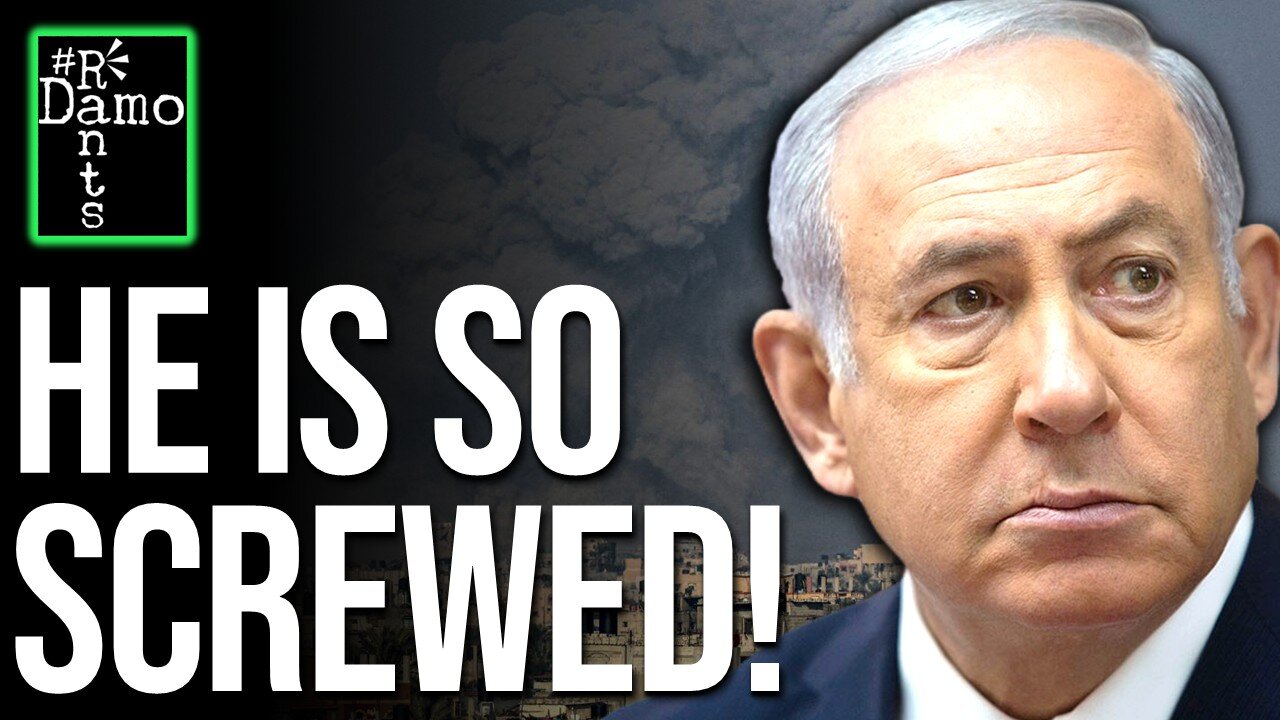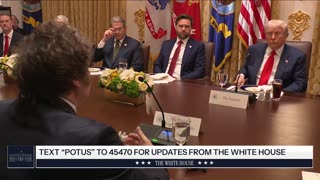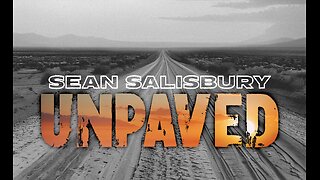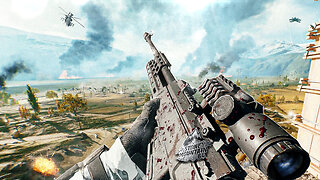Premium Only Content

The Ceasefire Was Meant to Save Gaza — It Might Destroy Netanyahu Instead
Right, so Israel’s army is pulling back from Gaza, or so the headlines say, but it’s hard to tell when every “exit” leaves another block in ruins. The ceasefire has technically begun; people are technically however still dying at Israel’s hands. Bulldozers are still finishing what the bombs started even as they leave, aid trucks queue behind tanks waiting to get in, yet still the world is calling this a win. The script has barely changed though. Occupy becomes withdrawing while still destroying, bombard becomes security while still destroying, and genocide gets rebranded as a ceasefire where everyone but Israel it seems has ceased firing. Israel may be leaving, but it’s seemingly making sure there’s nothing left to come back to for as many people in Gaza as possible and with Netanyahu still on the hook to the far right and with that corruption trial over his head still, with his situation unchanged, how can this ceasefire be different from the last? Or has something changed there?
Right, so a ceasefire usually means downing tools and the fighting ends. Israel never seem to get that do they? In Gaza, it means a change in language instead. The declaration of a promised an end to hostilities in the last two days, the release of captives, and the start of a reconstruction process has been made. Yet within hours, bombs were falling again. Israel insisted that it was going to uphold the ceasefire as soon as the cabinet passed it, pushing the timing of the ceasefire beginning back on their own terms. The genocide had not paused when it was supposed to; Netanyahu was playing for time is how this absolutely looked.
The ceasefire text looked comprehensive enough though. Israeli forces would withdraw from populated areas in stages. Palestinian groups would release hostages, Israel would also release hostages they hold, many more of them of course and humanitarian convoys would finally move freely. But on the ground, the picture was unchanged. Residential neighbourhoods were still hit, civilians were still being killed, and hospitals received dozens of new casualties. One strike on a family home in western Gaza killed more than seventy people. Civil-defence teams described entire streets reduced to rubble while the official truce apparently came into force.
So far it looks very much like a Lebanon-style ceasefire—a truce where only one side ceases, Israel having violated that nearly year long ceasefire thousands upon thousands of times. Israel framed the bombings as “defensive operations.” Mediators looked away. For many people who had been told about a ceasefire, they’ll have been wondering – what ceasefire exactly?
The prisoner-exchange agreement underpinning the truce had been hailed as the first serious diplomatic achievement in two years of genocide, even though we’ve seen these previously, back in January for example. About two thousand Palestinian prisoners ae to be released, including hundreds serving life sentences, in exchange for the remaining Israeli captives.
Inside Israel’s cabinet though, ministers from the far-right factions refused outright approval. Their doctrine rejects any negotiation that acknowledges Palestinian agency, and they refused to support it. Netanyahu, not needing their votes to get cabinet approval, has apparently managed to get it over the line after a few false starts.
The arrangement was shaped by foreign pressure as well. Washington wanted a headline that could be sold as progress—a “sustainable pause” rather than a full peace, no time constraints placed on this deal, which was seen as the reason the January one failed – because God forbid you see the whole thing through. The plan this time looked durable on paper because its architects cared more about appearance than enforcement.
The ceasefire’s fragility is rooted in Israel’s political arithmetic. Netanyahu governs through a coalition dominated by two far-right parties whose leaders control the finance and national-security portfolios. Without their support, his government collapses and the corruption trial awaiting him will be inescapable. Every military decision since 2023 has been shaped by that dependency.
Both ministers, Bezalel Smotrich and Itamar Ben-Gvir laid down their red lines. They would oppose any full withdrawal from Gaza, any release of high-profile prisoners, and any language implying Palestinian sovereignty. They demanded that the army retain “freedom of action” during the truce—effectively a license to keep bombing. The message was unambiguous therefore: continue the war or lose the government. The bombing has thusfar carried on and neither minister has yet taken their party out of government and collapsed the administration, though it could of course still happen at any time.
The January truce collapsed under the same pressure when one of the ministers withdrew support immediately, at that point not enough in itself to bring the coalition down, but when the other pledged to do that after phase 1, hostilities resumed within days. Netanyahu has since lost two other coalition parties and now either minister leaving would in themselves be able to collapse the coalition. Therefore, the pattern is institutionalised: every pause is temporary, every agreement conditional on domestic politics. The government’s survival depends on the genocide’s continuation. It does make you wonder however, why neither of them have left yet despite threatening it. Ben-Gvir went straight away in January, he hasn’t this time – has Netanyahu called their bluff, or has he had some kind of guarantee to protect his own backside if his administration collapses? All of that predicates on this ceasefire becoming the real deal and lasting of course and right now, we aren’t seeing that. Withdrawal and destruction are happening simultaneously.
No single issue exposed the fragility of the deal more clearly than the case of Marwan Barghouti. The imprisoned Fatah leader, serving multiple life sentences since 2002, commands respect across Palestinian factions and remains one of the few figures with broad popular legitimacy. In Palestine he is compared to Nelson Mandela. His inclusion on the prisoner-release list would have turned the ceasefire from a tactical pause into the start of a political process. That was precisely why it could not be allowed to happen.
In the final hours before the ceasefire announcement, Barghouti’s name was removed from the approved list. Mediators confirmed that his release had already been authorised. The deletion was ordered unilaterally by the prime minister’s office and justified after the fact as a “security decision.” The far-right ministers had publicly vowed that Barghouti would never leave prison; so Netanyahu capitulated. This part of the story implies he’s still held by the short and curlies by Smotrich and Ben-Gvir.
Palestinian negotiators obviously saw the change as a breach of faith, and mediators from Egypt and Qatar—who had brokered the lists—were blindsided. Here Netanyahu goes again, altering agreements post-signature, as he’s done so many times before.
Barghouti’s continued imprisonment also blocks any future political reconciliation. His presence in a post-war leadership is viewed by many as essential to unifying Gaza and the West Bank. By ensuring he stays behind bars, Israel removes the possibility of a legitimate Palestinian replacement authority to Hamas. The ceasefire thus becomes a mechanism to entrench division, not to resolve it.
Another name added to the ‘you can’t have them back’ list that has been announced this morning by Israel is Dr Hussam Abu-Safiya, the director of the Kamal Adwan Hospital, another high profile hostage, seized for daring to treat people ostensibly another finger flipped up at Gaza by Israel, another thorn in the side of this ceasefire having legs to stand on.
Within twenty-four hours of the truce taking effect, Gaza was again under bombardment. Strikes across western Gaza City, including the attack on the Ghaboun family home, killed and wounded scores of civilians. All occurred after the ceasefire start time. There were no verified reports of rocket fire from Palestinian factions during that period either, so its another case of everybody ceases, while Israel fires. A blatant unilateral breach.
Israel justified the attacks as operations against militants “exploiting the ceasefire.” The evidence did not support that claim. Civilian sites, not military positions, were hit. The repetition of January’s pattern was unmistakable: redefine offence as defence, reclassify civilians as combatants, and declare the ceasefire still intact. The mediators issued the usual statement calling for “restraint,” which, when Israel never shows any is getting a bit long in the tooth.
The effect was to normalise violence within the framework of peace. Each bomb became an act of “implementation.” In legal terms, the truce ceased to exist the moment offensive operations resumed; politically, it survived because admitting its failure would embarrass those who brokered it and of course people still hope to salvage it having got to where they have.
While Gaza continued to be hit, the United States announced the deployment of several hundred troops to “assist humanitarian logistics” and “monitor the ceasefire.” Officially, their duties are to be limited to engineering support and aid oversight. Unofficially, the deployment changed the entire dynamic of accountability.
The United States remains Israel’s principal arms supplier, providing billions in annual military assistance. To act simultaneously as monitor and armourer is a contradiction that cannot be reconciled. The presence of American personnel on the ground gives Israel diplomatic cover for future operations: any new offensive can be justified by the US presence. It should be a UN presence. That it isn’t should ring alarm bells.
No other nation has sent soldiers to oversee the ceasefire. European and regional partners restricted their participation to civilian monitors stationed outside Gaza. The result is a truce policed by one side’s chief ally. Humanitarian organisations have quickly warned that this arrangement destroys the credibility of any verification process. It turns supervision into complicity.
Aid agencies have already documented repeated Israeli strikes on humanitarian convoys and logistics hubs in previous months. Those incidents occurred while US oversight structures were nominally in place, overseeing those GHF aid hubs as they were. The new deployment changes nothing except optics: it suggests control without providing protection. Gaza’s local authorities have therefore called for an independent verification mechanism under international—not bilateral—authority. That demand has been ignored.
Behind the shifting headlines, the deeper war continues against Gaza’s ability to live. The territory’s physical and economic devastation is almost total. Satellite images show districts flattened block by block. The most comprehensive damage is in agriculture. Gaza’s government estimates daily losses of roughly ninety-six million dollars. About two hundred and forty dunams of farmland—nearly sixty acres—are destroyed each day, along with wells and livestock farms. Independent data from UN agencies confirm the pattern: over ninety-five percent of arable land has been rendered unusable, and nearly all cropland is inaccessible or destroyed.
This destruction is not the by-product of fighting; it is the continuation of siege by other means. The elimination of Gaza’s food system guarantees dependence on aid and prevents any autonomous recovery. Under international humanitarian law, attacks on food production and water sources are prohibited because they make civilian survival impossible. The record now shows that these prohibitions are being ignored on a systematic scale.
Before the genocide, Gaza produced most of its own vegetables and poultry. Today, even basic self-sufficiency is impossible. Soil contamination, destroyed irrigation, and the loss of seeds and livestock have ended local farming. The humanitarian agencies assessing the situation classify the north of Gaza as facing famine conditions. The continuation of bulldozing on the way out during a declared truce can only be read as an intentional policy to prolong those conditions.
By crippling agriculture, Israel ensures that any future Palestinian administration will depend entirely on external funding and political approval from the occupying power and the world cannot walk away from this when the dust finally does settle and let that happen. Aid distribution will become permanent a tool of control. What may appear as reconstruction in due course, would in fact be management of deprivation. The ceasefire, in this light, is not the end of conflict but its economic evolution.
Neighbouring states responded with wary cynicism to this ceasefire as well. Regional powers warned that Israel’s pattern of behaviour—agreeing to a ceasefire while continuing strikes and ending them as soon as they feel like it—fit a familiar template. Their statements predicted that the truce would be used to regroup militarily rather than to negotiate. Subsequent events in previous ceasefires have proved them correct on this in the past.
Within Palestinian politics, the response was unanimous rejection of any foreign “guardianship” over Gaza. Proposals circulating in Western capitals to appoint an external administrator for reconstruction—possibly Tony Blair—were dismissed as white supremacist and neo-colonial. I would agree with that. Local factions insist that reconstruction must be led by Palestinians themselves and it should. After two years of devastation, they see external trusteeship as a continuation of the same system that allowed the genocide to happen.
Their scepticism is justified and rooted in precedent. Every major ceasefire since 2006 has collapsed once Israel reinterpreted its obligations. The difference now is scale: the destruction of Gaza’s economy and farmland has locked the territory into dependency even if the guns finally fall silent for good. The genocide’s goals are being achieved without open fire. Perhaps that is why Netanyahu feels now the time is right? He’s already won. If life is now impossible in Gaza, people will inevitably have to leave or perish. Perhaps that is the logic now? Doesn’t get him off his corruption charges though does it?
That said, he’s not getting off the hook that easily. Gaza’s authorities submitted formal requests for an international investigation into Israel’s conduct, which is essential. The charge of genocide must be investigated regardless of what happens now. They argued that continued bombardments, infrastructure demolitions, and economic destruction under a declared truce constituted grave breaches of international law to add to the long list Israel already stands accused of. These requests referenced existing treaty provisions that require immediate inquiry into such actions.
The evidence required for such a probe—satellite data, hospital records, and field reports—already exist, provided Israel hasn’t destroyed them in further bombardments, we need to see that happen.
But the very countries that built the legal system are the ones obstructing it. When a state that supplies the bombs also vetoes investigation into their use, what even is law anymore? Gaza’s experience exposes that contradiction more clearly than any academic debate could certainly.
As of time of writing, Israeli forces have continued withdrawing from parts of Gaza under the ceasefire framework, while airstrikes and helicopter attacks were still being reported in and around Gaza City after the pause took effect. Independent reporters documented civilian casualties at residential sites during those hours. Bombardments slowed but did not cease.
Politically, the arrangement has kept the Israeli government intact and provided its allies with the illusion of progress. Smotrich and Ben-Gvir continue to dictate red lines, but they haven’t yet left; Netanyahu continues to balance between their demands and foreign expectations. Nothing in the truce framework can evolve into peace because peace would dismantle the coalition that sustains it. Despite Trump’s 20 point peace plan, its not very clear what the incentive for Israel to suddenly pull back after deciding to total Gaza City is and in what way that is thusfar not collapsing Netanyahu’s government. You just feel like we don’t know all the variables here.
Economically, the devastation has entrenched a humanitarian crisis now measured in millions of tons of rubble and billions in lost output. With nearly all farmland destroyed and livestock wiped out, Gaza’s population is dependent on controlled aid corridors that Israel can open or close at will. This is siege economics, calibrated to produce compliance through exhaustion.
Diplomatically, the US troop presence has turned the ceasefire into a bilateral arrangement between allies rather than an international agreement. Any future escalation can be presented as mutual defence, not aggression. That inversion of roles—where the monitor becomes the participant—ensures that accountability could be complicated significantly.
Regionally, the sceptics have been vindicated. Israeli operations continue along the Lebanese border, justified as “preventive security,” while airstrikes in Gaza are still reported intermittently. The truce exists only within the discourse of those who need it to exist. On the ground, the conflict persists. Will it finally all stop today or will we have more casualty reports tomorrow?
The wider implication of this ceasefire lies in what it reveals about the erosion of international norms. The principles that once constrained warfare—distinction, proportionality, necessity—have been hollowed out completely, because this was genocide. But states now speak of “balance” instead of law, “security” instead of accountability. Each time a civilian area is bombed under a truce, the precedent deepens. Each silence from the institutions meant to prevent it erodes their legitimacy.
A ceasefire that allows killing to continue is not a ceasefire; it is continuity with added diplomatic cover. This latest agreement was sold as a turning point, yet every measurable fact thusfar shows the same reality: civilians dead after the truce began, farmland erased, aid restricted, and mediators sidelined. The structure of the deal guarantees on the face of it, another inevitable failure and we can’t tolerate that.
This matters beyond Gaza. Every government watching will learn the same lesson: that international law is optional, accountability negotiable, and morality expendable. It all gets weakened and that threatens every one of us. The precedent will not stay confined to one border. What collapses in Gaza today will collapse elsewhere tomorrow.
For more on Israel taking liberties with this ceasefire, do check out this video recommendation here as your suggested next watch.
Please do also hit like, share and subscribe if you haven’t done so already so as to ensure you don’t miss out on all new daily content as well as spreading the word and helping to support the channel at the same time which is very much appreciated, holding power to account for ordinary working class people and I will hopefully catch you on the next vid. Cheers folks.
-
 1:20:21
1:20:21
The Confessionals
3 hours agoInside the Invisible War (Demons Don't Fight Fair)
2491 -
 1:07:45
1:07:45
The White House
3 hours agoPresident Trump Participates in a Bilateral Lunch with the President of the Argentine Republic
24.6K13 -
 2:13:35
2:13:35
Barry Cunningham
3 hours agoBREAKING NEWS: PRESIDENT TRUMP AND PRESIDENT OF ARGENTINA JAVIER MILEI MEET
17.6K4 -
 5:22
5:22
Michael Heaver
4 hours agoFarage Issues URGENT Warning To Britain
4.13K2 -
 1:22:01
1:22:01
Sean Unpaved
5 hours agoMNF Madness, CFB Week 7 Rewind, & MLB's ALCS & NLCS Playoff Fire!
26.7K -
 1:02:05
1:02:05
DeVory Darkins
3 hours ago $32.19 earnedTrump drops NIGHTMARE News on Democrats as the Violent protestors gear up
109K49 -
 1:59:08
1:59:08
The Charlie Kirk Show
4 hours agoCharlie’s 32nd Birthday + Medal of Freedom | Sec. Bessent, Lavorgna, Zeldin, Sen. Lee | 10.14.25
95.6K95 -
 LIVE
LIVE
StoneMountain64
2 hours agoBattlefield 6 Sniping and Unlocking SNIPERS from LONG RANGE
68 watching -
 2:50:25
2:50:25
Side Scrollers Podcast
4 hours agoHasan CAUGHT Red Handed + Hogwarts Legacy 2 “Boycott” + Arbys SUED + More | Side Scrollers
32.4K3 -
 1:08:02
1:08:02
Timcast
4 hours agoTrump DOJ DEFIES THE COURTS, Tear Gasses Anti Ice Rioters, Civil War Fears Escalate
138K152